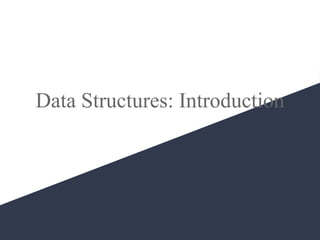
data types.pptx
- 2. 2 Data Types & Data Structures • Applications/programs read data, store data temporarily, process it and finally output results. • What is data? Numbers, Characters, etc. Application/ Program Data Data
- 3. 3 Data Types & Data Structures • Data is classified into data types. e.g. char, float, int, etc. • A data type is (i) a domain of allowed values and (ii) a set of operations on these values. • Compiler signals an error if wrong operation is performed on data of a certain type. For example, char x,y,z; z = x*y is not allowed.
- 4. 4 Data Types & Data Structures • Examples Data Type Domain Operations boolean 0,1 and, or, =, etc. char ASCII =, <>, <, etc. integer -maxint to +maxint +, _, =, ==, <>, <, etc.
- 5. 5 Data Types & Data Structures • int i,j; i, j can take only integer values and only integer operations can be carried out on i, j. • Built-in types: defined within the language e.g. int,float, etc. • User-defined types: defined and implemented by the user e.g. using typedef or class.
- 6. 6 Data Types & Data Structures • Simple Data types: also known as atomic data types 🡪 have no component parts. E.g. int, char, float, etc. 21 3.14 ‘a’
- 7. 7 Data Types & Data Structures • Structured Data types: can be broken into component parts. E.g. an object, array, set, file, etc. Example: a student object. A H M A D 20 C S C Name Age Branch A Component part
- 8. 8 Data Types & Data Structures • A data structure is a data type whose values (i) can be decomposed into a set of component elements each of which is either simple (atomic) or another data structure (ii) include a structure involving the component parts.
- 9. 9 Data Types & Data Structure Possible Structures: Set, Linear, Tree, Graph. SET LINEAR TREE GRAPH
- 10. 10 Data Types & Data Structures • What is the domain of a structured data type? Operations? • Example: boolean[] Sample[3]; 000 001 010 011 100 101 110 111 Domain 1 0 0
- 11. 11 Data Types & Data Structures • Example: Operations: Sample[0] = True; C = Sample[1]; etc. Elements Structure Domain Operations Data Type/ Structure
- 12. 12 Abstract Data Types (ADTs) • Abstraction? Anything that hides details & provides only the essentials. • Examples: an integer 165 = 1.102+6.101+5.100, procedures/subprograms, etc. • Abstract Data Types (ADTs): Simple or structured data types whose implementation details are hidden…
- 13. 13 ADTs • While designing ADTs, a designer has to deal with two types of questions: – (i) What values are in the domain? What operations can be performed on the values of a particular data type? – (ii) How is the data type represented? How are the operations implemented?
- 14. 14 ADTs • ADTs specification answers the ‘what’ questions. Specification is written first. • ADTs implementation answers the ‘how’ questions. Done after specification. • Users & Implementers. • Users of an ADT need only know the specification …. no implementation details.🡪 advantage • Programmer (Implementer) who implements ADT is concerned with..specification, representation, implementation.
- 15. 15 ADTs Elements Structure Operations Domain Specification Representation Implementation User of an ADT must know only this Implementer must know all these.
- 16. 16 ADT: Example ADT String1 Specification: Elements: type char. Structure: elements (characters) are linearly arranged. Domain: type String, finite domain, there are 0 to 80 chars in a string, therefore 1+128+1282+…..+12880 possible stings in the domain. Operations: Assume that there is a string S. 1.Procedure Append (c: char) Requires: length(S) < 80. Results: c is appended to the right end of S.
- 17. 17 ADT: Example 2. Procedure Remove (c: char) Requires: length(S) > 0. Results: The rightmost character of S is removed and placed in c, S’s length decreases by 1. 3. Procedure MakeEmpty () Results: all characters are removed. 4. Procedure Concatenate (R: String) Results: String R is concatenated to the right of string S, result placed into S. 5. Procedure Reverse () 6. Procedure Length (L: int) 7. Procedure Equal (S: String, flag: boolean) 8. Procedure GetChar (int i)
- 18. 18 Note .. • In Java the class construct is used to declare new data types. • In Java operations are implemented as function members of classes or methods.
- 19. 19 ADT String: Implementation public class String1 extends Object { private char[] str; private int size; public String1 () { size = -1; str = new char[80]; } public void Append (char c) { size++; str[size] = c; } Implementation Representation
- 20. 20 ADT String: Implementation public char Remove (){ char c = str[size]; size--; return(c); } public char GetChar(int i){ return(str[i]); } public void MakeEmpty (){ size = -1; } public int Length (){ return(size); }
- 21. 21 ADT String: Implementation public void Concatenate (String1 s){ for (int i = 0; i<=s.Length(); i++) { char c = s.GetChar(i); Append(c); } } public boolean Equal (String1 s){ } public void Reverse () { } }
- 22. 22 Using ADT String import java.lang.*; public class Test { public static void main(String[] args) { String1 s = new String1(); String1 s1 = new String1(); System.out.println("Hello, World"); s.Append('a'); s1.Append('b'); s.Concatenate(s1); System.out.print(s.GetChar(0)); System.out.println(s.GetChar(1)); }